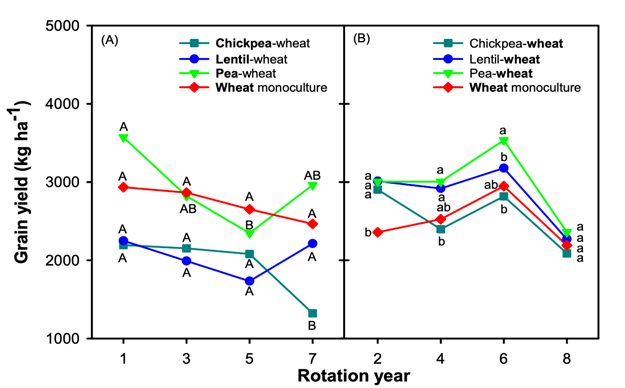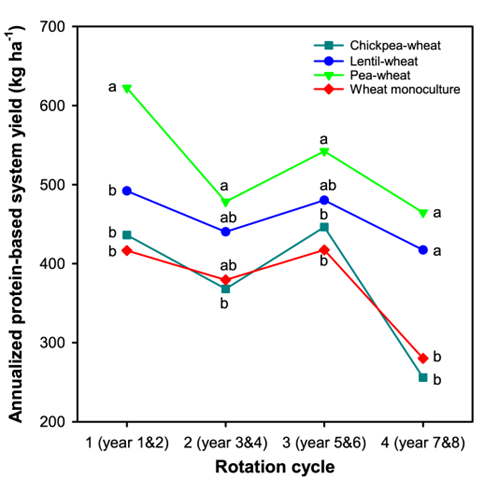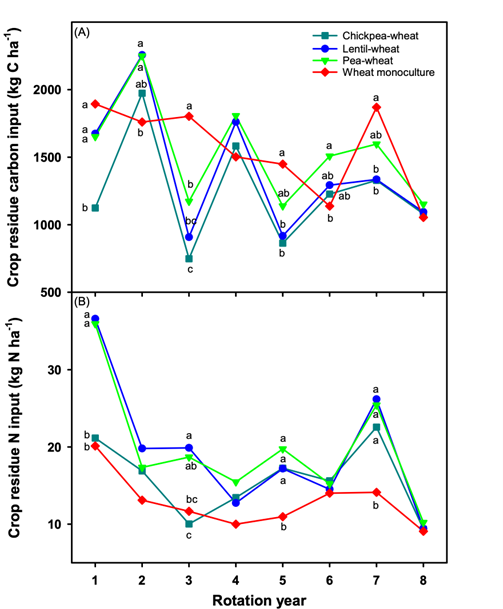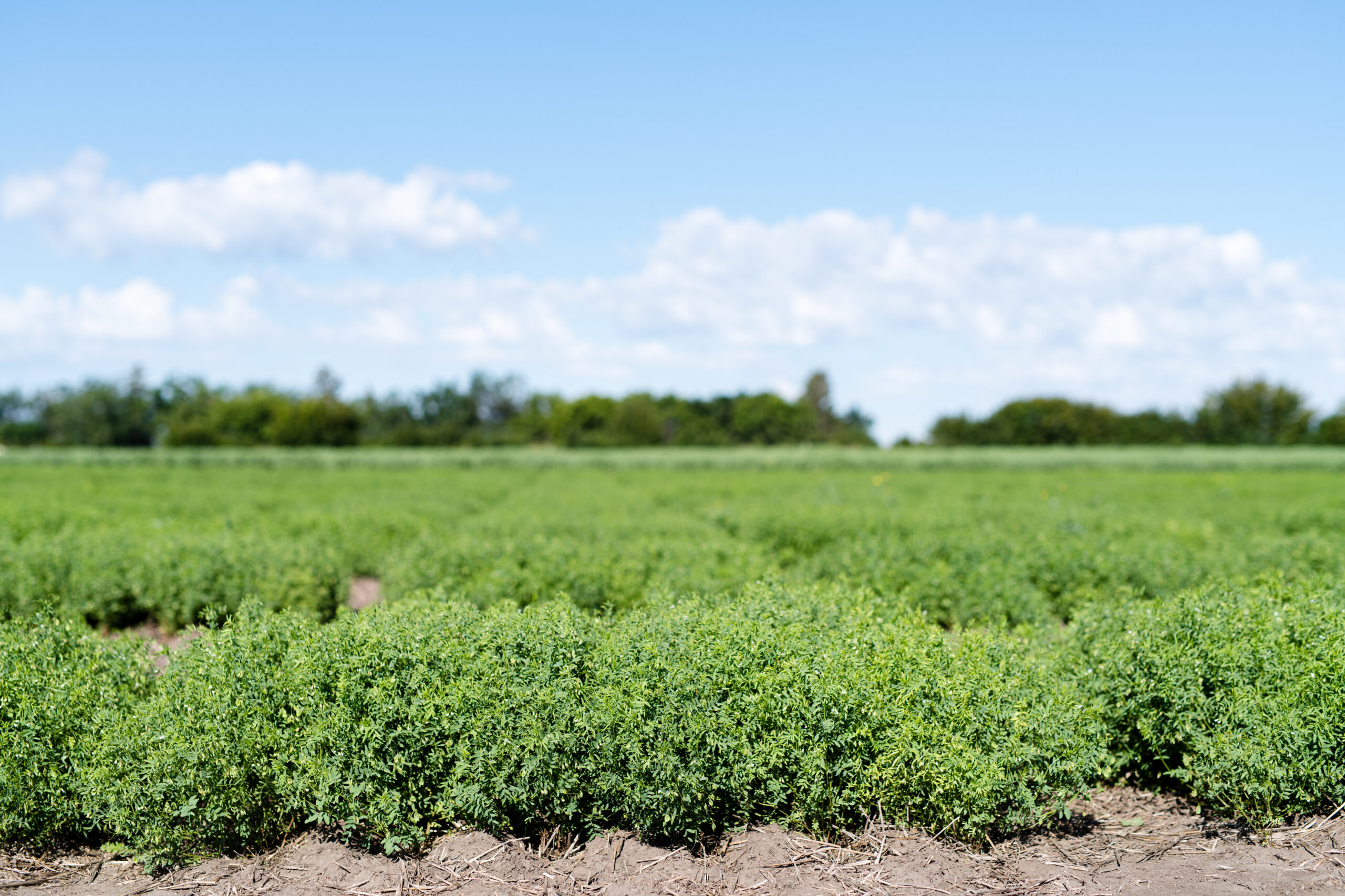This is one of seven research objectives explored under the project “Enhancing the Long-Term Sustainability of Pulse Cultivation Using System Approaches”.
Research collaborators: Dr. Kui Liu, Dr. Manjula Bandara, William May, Dr. Yantai Gan
Summary prepared by Jennifer Bogdan, PAg, CCA
Background
Pulse crops in the Canadian Prairies have been effectively incorporated into cereal and oilseed rotations, providing benefits such as reduced nitrogen (N) fertilizer usage, improved soil quality, a break-crop for cereal and oilseed host-specific pathogens, and increased overall crop system productivity. However, some farmers have experienced that intensifying pulse crops in rotations, where a high frequency of pulses are grown in the rotation, may have a negative impact on their overall productivity, such as having more frequent disease issues. Also, there are still unknown effects of pulse intensified rotations on soil carbon, soil nitrogen, soil microbial community, and production sustainability. This research objective aimed to provide information on the impact of using pulse crops more frequently in rotations and the effect of pulse intensified rotations on the cropping system as a whole.
Key Findings
- Growing pea (P) or lentil (L) before wheat (W) consistently increased the wheat crop yield. Growing chickpea (C) before wheat had a less consistent impact on the wheat crop yield due to its deep root system removing more water from the soil profile and the lack of competitiveness that chickpea exhibits towards weeds.
- A 2-year pea-wheat rotation had the greatest protein-based yield due to high pea and wheat grain yields, as well as higher protein in the wheat grain.
- Cumulative carbon added to the system from crop residue after the 8-year rotation was: P-W = W-W > L-W = C-W. Cumulative nitrogen from crop residue was: P-W > L-W > C-W = W-W.
- Pulse crop rotations had higher concentrations of nitrogen in the top 30 cm (1 foot) of soil compared to continuous wheat.
- Growing pea every other year had the greatest effect on pea yield, regardless of the crop grown between the pea years.
Experiment 1 – Optimizing Crop Rotation Systems for Dry Ecoregions of Western Canada
Research Methodology
An 8-year study consisting of two 4-year crop rotations was carried out at three locations between 2010 and 2019 (Table 1). Two experimental locations were in Swift Current, SK, conducted from 2010–2017 at one site and 2011–2019 at another site (no plots were established in 2015), and one location was in Brooks, AB from 2011–2018. Plots were direct seeded into wheat stubble in Year 1 and were managed using no-till practices. Wheat plots in the first year of each 4-year rotation received nitrogen fertilizer at 71 lb N/ac (80 kg N/ha); in other years, wheat plots were fertilized at 45 lb N/ac (50 kg N/ha). Each year, all plots received phosphorus fertilizer at 20 lb P/ ac (22 kg P/ha). Pulse crops were inoculated with their appropriate
Rhizobium granular inoculants. Glyphosate at 180 gai/ac was used as a pre-seed burn-off for all plots, and pulse plots received an application of trifluralin after seeding to mitigate the effect of weeds on pulse growth. Cultivars used were Lillian (hard red spring wheat), Brigade (durum wheat), Transcend (durum wheat), CDC Amarillo (yellow field pea), CDC Leader (kabuli chickpea), CDC Maxim (small red lentil, Clearfield tolerant), CDC Impulse (small red lentil, Clearfield tolerant), and Cutlass (oriental mustard).
Table 1. Crop rotation treatment structure
| Treatment | Year 1; Year 5 | Year 2; Year 6 | Year 3; Year 7 | Year 4; Year 8 | Rationale |
| 1 | Wheat | Wheat | Wheat | Wheat | Continuous wheat as a control system |
| 2 | Pea | Wheat | Wheat | Wheat | 1 pulse every 4 years (can a pea crop function as green fallow?) |
| 3 | Chickpea | Wheat | Wheat | Wheat | 1 pulse every 4 years (can deep-rooted chickpea function as shallow-rooted pea?) |
| 4 | Pea | Wheat | Pea | Wheat | 2 pea crops every 4 years, alternated with a wheat break |
| 5 | Pea | Wheat | Lentil | Wheat | 2 lentil-pea alternated every 4 years, with a wheat break |
| 6 | Lentil | Wheat | Chickpea | Wheat | 2 pulses every 4 years, shallow- and deep-rooted pulses alternated with a wheat break |
| 7 | Lentil | Wheat | Lentil | Wheat | 2 lentil crops every 4 years, shallow-rooted lentil alternated with a wheat break |
| 8 | Chickpea | Wheat | Chickpea | Wheat | 2 chickpea crops every 4 years, alternated with a wheat break |
| 9 | Pea | Mustard | Chickpea | Wheat | 2 shallow- and deep-rooted pulses every 4 years, with oilseed and wheat alternated breaks |
| 10 | Pea | Mustard | Lentil | Wheat | 2 shallow-rooted pulses every 4 years, with oilseed and wheat breaks |
| 11 | Pea | Pea | Pea | Wheat | 3 consecutive shallow-rooted pea crops every 4 years with a wheat break |
| 12 | Lentil | Lentil | Lentil | Wheat | 3 consecutive shallow-rooted lentil crops every 4 years with a wheat break |
| 13 | Chickpea | Mustard | Chickpea | Wheat | 2 deep-rooted chickpea crops every 4 years with oilseed and wheat breaks |
| 14 | Lentil | Chickpea | Pea | Wheat | 3 different pulses alternated in 4 years with a wheat break |
Grain Yield Results
Four rotations were used to measure the agronomic effect of pulse crops in a cropping system: WWWW (continuous wheat), PWPW (pea-wheat), LWLW (lentil-wheat), and CWCW (chickpea-wheat). Grain yields during the pulse years (phases) were affected by crop type and the year. Lentil and wheat yields did not change significantly during the four pulse phases; however, pea and chickpea yields varied depending on the year (Figure 1A). There was a 52% increase in pea yields from the lowest yield (year 5) to the highest yield (year 1). Chickpea yields increased by 66% from the lowest yield (year 7) to the highest yield (year 1).
During the wheat phases, grain yields were affected by the preceding pulse crop and the year (Figure 1B). Growing pea or lentil the year before wheat consistently increased wheat yields by 8–27% for pea and 5–28% for lentil, compared to continuous wheat. Chickpea had an inconsistent effect on the following wheat crop, with wheat yields being 23% higher than continuous wheat in the first rotation but 4–5% lower in the following three rotations.

One explanation for chickpeas having a less consistent impact on yield of the succeeding wheat crop could be due to the root system of the crop. Chickpea is a deep-rooted pulse, compared to shallow- rooted pea and lentil, allowing the crop to remove more water from the soil profile. Chickpeas can extract water from depths of 1.2 meters, similar to a cereal crop. Since water is a critical limiting factor for crop production in the semi-arid regions of the Prairies, deep-rooted crops such as chickpeas leave less water behind for subsequent crops, impacting their yields if inadequate rainfall is received. Chickpea is also a poor competitor against weeds. Weed infestations that occur in a chickpea crop can build the weed seedbank, allowing for higher weed pressure in subsequent wheat crops. Although chickpea does provide a N benefit for the following wheat crop, the decreased residual soil water and higher weed pressure in the wheat crop may negate this N benefit.

To more accurately compare yield performance of cropping systems containing different crops, the grain yield of each crop was converted to a protein-based yield (PBY), where PBY = grain yield x %N of grain x 6.25/100 (note: 6.25 is the conversion factor used for converting %N to %protein). The average PBY after 2 years of each crop rotation was then used to measure the yield performance of the cropping system (protein-based system yield, or PBSY). Pea-wheat most consistently had the greatest impact on protein, with PBSY either equal to or higher than that of L-W, C-W, and continuous wheat (Figure 2). This result was due to the high pea and wheat yields, as well as the higher wheat protein in the P-W rotational system. PBSY was 26–49% higher in P-W and 15–49% higher in L-W than W-W after any given 2-year rotation. Chickpea-wheat PBSY did not differ significantly from continuous wheat due to low chickpea yields as well as low wheat yields following the chickpea crop.
Crop Residue, Soil Carbon, and Soil Nitrogen Results

Crop residue carbon and nitrogen input to the soil were both measured (Figure 3). Of the three rotations containing a pulse crop, the P-W rotation resulted in the highest amount of carbon input from crop residue, followed by L-W, and lastly, C-W. For all rotations, in the pulse years (years 1, 3, 5, 7), continuous wheat produced the highest amount of crop residue carbon due to the higher amount of plant biomass produced in a wheat crop relative to a pulse crop. Conversely, in the wheat years (years 2, 4, 6, 8), the W-W rotation produced the lowest amount of crop residue carbon compared to the pulse crop rotations, since pulse crops generally increase the crop biomass of the following wheat crop.
The results for crop residue N input found no differences between rotations in the wheat years (years 2, 4, 6, 8), but there were significant N input differences in the pulse years (years 1, 3, 5, 7). Crop residue N input in continuous wheat was equal to or significantly lower than any of the pulse rotations throughout all 8 years of the study. Within the pulse rotations, the crop residue N input from pea was 12–70% higher than that of chickpea (although only statistically significant in one year), and pea residue N input was not significantly different from lentil.
Cumulative crop residue carbon and nitrogen input – the amount of carbon and N in crop residue added to the system throughout the 8-year study – were also determined. Cumulative carbon of P-W and W-W were the same (12.1 and 12.0 mt carbon/ha, respectively). Of the pulse crop rotations, the cumulative crop carbon of P-W was significantly higher than L-W (10.3 mt carbon/ha) and C-W (9.1 mt carbon/ha). More significant differences between the four crop rotations were observed with cumulative crop residue N. Pea-wheat cumulative N (155 kg N/ha) was significantly higher than L-W (133 kg N/ha), which in turn was significantly higher than C-W (109 kg N/ha). No statistical difference was found between C-W and continuous wheat.
Soil organic carbon at 0–15 cm depth was measured at the start of the experiment and at the end of year 8. The starting soil organic carbon concentration was 10.3 g carbon/kg and at the end of the experiment, organic carbon values were 10.8, 11.4, 10.9, and 11.7 g carbon/kg for W-W, P-W, L-W, and C-W, respectively. Although these differences were not statistically significant, the research showed that rotations including pulse crops can increase soil organic carbon over time. Despite their lower crop residue production, pulse crops increase the yield of the wheat crop grown in subsequent years, helping to compensate for their own reduced biomass. In addition, below-ground crop residue of a pulse crop such as chickpea that has a large root-to-shoot ratio can also compensate for lower above-ground residue production.
Soil mineral nitrogen in the 0–60 cm depth was measured prior to seeding wheat in the second, fourth, and eighth years of the study. Rotations with pulse crops had higher concentrations of soil N compared to continuous wheat. There were no significant differences in soil N concentration among the pea, lentil, and chickpea rotations, and nitrogen contributions remained in the top 30 cm of the soil. Pulse crops fix their own nitrogen, thereby removing less N from the soil compared to wheat, and their N-rich residues break down quickly releasing nitrogen into the soil, explaining the positive effect on soil N from pulse crop rotations.
Experiment 2 – Optimizing Canola Intensified Crop Rotation Systems for Humid Ecoregions of Western Canada
Research Methodology
An 8-year pulse and canola intensified crop rotation study was carried out in Indian Head, SK from the spring of 2012 until the fall of 2019. Five crops – pea (P), lentil (L), canola (C), wheat (W), and oat (O) – were grown in 6 different 4-year rotations for 2 cycles of each rotation (Table 2). Crop varieties used in the trial were CDC Golden peas (2012–2014) and CDC Amarillo peas (2015–2019); CDC Maxim CL lentils; InVigor® L150 canola (2012), InVigor® 5540 canola (2013), InVigor® L252 canola (2014–2015), InVigor® L140 canola (2016– 2018), and LL 233P canola (2019); AC Unity VB wheat (2012–2016) and AAC Prevail wheat (2017–2019); Triactor oats (2012–2016) and AAC Justice oats (2017 and 2019). Pulse crops were inoculated at the time of seeding.
Table 2. Pulse and canola intensified rotation systems and phases in Indian Head
| Phase in Rotation | Rotations | |||||
| 1 | 2 | 3 | 4 | 5 | 6 | |
| A (pea stubble) | Wheat | Wheat | Wheat | Wheat | Wheat | Wheat |
| B (wheat stubble) | Canola | Pea | Pea | Pea | Lentil | Canola |
| C (broadleaf stubble) | Oat | Oat | Canola | Lentil | Oat | Pea |
| D (oat, canola, lentil, or pea stubble) | Pea | Pea | Pea | Pea | Pea | Canola |
| Rationale | Cereal- oilseed- pulse in a rotation, expected to be the most sustainable rotation system | Intensified pea-based rotation with cereal as a break crop | Intensified broadleaf crop with 1 cereal as a break crop | Intensified pulse- based rotation, 2 pulse species with 1 cereal as a break crop | Intensified pulse- based rotation, 2 pulse species with cereal as a break crop between | Intensified canola- based rotation with cereal and pulse between |
Grain Yield Results
Pea yield was significantly higher in the WCOP and WLOP rotations than in both pea years (phases) of WPOP and WPCP, and the fourth year of WPLP. Growing pea every other year had the greatest effect on pea yield, regardless of the crop grown between the pea years, even if that crop was a pulse crop. It should be noted that this study was conducted before soil-borne diseases, such as Aphanomyces, became apparent. These results found that growing three pulse crops in a row (WPLP) did not seem to worsen the yield impact of growing peas every other year. Additionally, pea yield was not affected in the WLOP rotation where lentil was the second crop compared to the negative effect on pea yield where pea was the second crop (WPOP). Of consideration is the below average rainfall received in 2017 and 2018 that could have allowed growing pulse crops in 3 out of 4 years, without having disease issues. In this study, growing canola every second year did not have negative impacts on grain yield or quality, and both wheat and oat were not affected by other crops in the rotation.
Conclusions
This research found that increasing the frequency of pulse crops in a rotation did not have a negative effect on soil quality from the lower amount of crop residue produced by pulses. Although pulse crops do leave less crop residue behind, the increased crop residue from the succeeding wheat crop can partially compensate for the lower residue in the pulse year. Additionally, deep-rooted pulse crops such as chickpea contribute below-ground residue to the cropping system. Pea and lentil added to the rotation can greatly increase the grain and protein-based yield of the following wheat crop. Pulse crops also contribute to the cropping system by increasing the amount of soil nitrogen compared to continuous wheat.
Acknowledgements
This project was funded by Saskatchewan Pulse Growers, the Saskatchewan Ministry of Agriculture – Agricultural Development Fund, and Agriculture and Agri-Food Canada.



